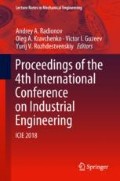Abstract
The article is devoted to the development of a mathematical model of the combined grinding process. Based on the main provisions of the theory of abrasive processing, dependences are developed to calculate the probability of removal of the material at any point of the contact zone taking into account several simultaneous processes of formation. The electrochemical grinding model presented in the article makes it possible to determine the removal of material from the workpiece taking into account the process of anodic dissolution, mechanical cutting, and their combination of the above processes. In the course of the work, equations are obtained that show that the processing of precision surfaces by a grinding wheel by the CBS method in comparison with the processing of blanks in accordance with the traditional algorithm provides higher accuracy and productivity. The complexity of the physical processes of surface formation connected with a large number of technological factors, with the help of which the parameters of this process can be changed, is shown. The model takes into account the peculiarities of the stochastic nature of the abrasive processing process and the interaction of additional physical processes and technological factors. During the development of the model, graphical dependences of the gap size for any point of the contact zone and the total gap of the part with the circle from the process parameters were obtained. An example of the calculation of the electrochemical removal of material from the unit area of the developed model is given.
Access this chapter
Tax calculation will be finalised at checkout
Purchases are for personal use only
References
Mankov VV (2015) Improvement of technology of finishing of surface treatment surfaces of complex forms. Youth Sci 4:52
Kozak J, Skrabalak G (2014) Analysis of abrasive electrochemical grinding process (AECG). In: Ao SI et al (eds) Proceedings of the world congress on engineering 2014, vol II, London, pp 1147–1152, 2–4 July 2014
Bratan SM (2006) Technological fundamentals for assurance of quality and stability increase in efficient finishing and fine grinding. Dissertation, Sevastopol
Rychkov DA, Yanushkin SA, Petrov NP, Guruleva GV, Stefankiv II Celine NV (2015) Progressive structures of grinding circulars for combined electrochemical sanding. Mech XXI Century 14:126–131
Safonov SO, Yanushkin AS, Trufanov AY (2003) Electrochemical processes on the surface of a diamond circuit in electrochemical sanding. Proc Fraternal State Univ Ser Nat Eng Sci 2:79–83
Suriev AA, Safonova DS (2012) The role of electrolyte in the electrochemical sanding process. Mech XXI Century 11:239–241
Polyanchikov YN, Kurchenko AI, Emelianenko AA (2003) Concept of development of electrochemical grinding process by new abrasive circles without binding. Technol Mech Eng 2:10–12
Yanushkin AS, Medvedeva OI, Arkhipov PV, Popov VYu (2010) The mechanism of formation of protective films on diamond circles with a metal bond. Syst Methods Technol 1(5):132–138
Rajurkar KP, Zhu D, Mc Geough JA, Kozak J, DeSilva A (1999) New developments in electro-chemical machining. Ann CIRP 48(2):569–579
Kozak J (1996) Selected problems of hybrid electro-mechanical machining. Arch Mech Technol Autom 16:59–65 (in Polish)
Yanyushkin AS, Lobanov DV, Bataev VA, Arkhipov PV, Medvedeva OI (2010) Research workability of diamond circles in the processing of composite materials. Syst Methods Technol 7:87–91
Kozak J, Skrabalak G (2014) Analysis of abrasive electrochemical grinding process (AECG).In: Proceedings of the World Congress on Engineering, vol II, WCE 2014, London, UK, 2–4 July 2014
Gupta R, Chahal B (2015) Investigation and optimization of process parameters in electrochemical aid abrasive flow machining. Int J Sci Eng Res 6(2)
Artamonov BA (1983) Electrophysical and electrochemical methods of processing. Higher School, Moscow
Lobanov DV, Yanushkin AS (2012) Perspectives of development of electrochemical sanding of machine and tool parts. In the collection: problems of mechanics of modern machines, materials of the V international conference, pp 167–171
Roy S, Bhattacharyya A, Banerjee S (2007) Analysis of effect of voltage on surface texture in electrochemical grinding by autocorrelation function. Tribol Int 40:1387–1393
Roshchupkin SI, Sazonov SE, Bratan SM (2015) Identification of removal parameters for combined grinding of current-conducting ceramic materials. In: Collection modern directions and prospects for the development of processing technologies and equipment in mechanical engineering, materials of the international scientific and technical conference pp 108–112
Bratan SM, Bogutsky VB, Kolesov AG (2016) Mathematical modeling of the process of fine-tuning of precision surfaces of elastic plates with surfactants. High Technol Eng 10(64):26–32
Puri AB, Bhattacharya B (2005) Modelling and analysis of white layer depth in wire-cut EDM process through response surface methodology. Int J Adv Manuf Tech 25:301–307
Novoselov Y, Bratan S, Bogutsky V (2016) Analysis of relation between grinding wheel wear and abrasive grains wear. Procedia Eng 150:809–814
Popilov LY (1971) Handbook of electrical and ultrasonic methods of processing materials. Mechanical Engineering, Leningrad
Novosyolov YК (2017) Surface shaping dynamics during abrasive processing. LAP LAMBERT Academic Publishing, p 317
Lobanov DV, Yanushkin AS, Kirpikova EI, Yakovets AV, Cheremnykh AS (2012) Comparative analysis of methods of combined diamond processing of solid alloys. Mech XXI Century 11:155–159
Novoselov YK (2012) The dynamics of shaping surfaces during abrasive processing. SevNTU, Publ., Sevastopol
Bratan S (2006) Technological bases of quality assurance and increase in stability of high-productive fine grinding. Dissertation, Odessa
Bratan S (1997) The probabilistic approach for modeling of electroerosion grinding. Bull SevGTU Ser Autom Control 7:140–144
Author information
Authors and Affiliations
Corresponding author
Editor information
Editors and Affiliations
Rights and permissions
Copyright information
© 2019 Springer Nature Switzerland AG
About this paper
Cite this paper
Bratan, S., Bogutsky, B., Roshchupkin, S. (2019). Development of Mathematical Model of Material Removal Calculation for Combined Grinding Process. In: Radionov, A., Kravchenko, O., Guzeev, V., Rozhdestvenskiy, Y. (eds) Proceedings of the 4th International Conference on Industrial Engineering. ICIE 2018. Lecture Notes in Mechanical Engineering. Springer, Cham. https://doi.org/10.1007/978-3-319-95630-5_189
Download citation
DOI: https://doi.org/10.1007/978-3-319-95630-5_189
Published:
Publisher Name: Springer, Cham
Print ISBN: 978-3-319-95629-9
Online ISBN: 978-3-319-95630-5
eBook Packages: EngineeringEngineering (R0)

